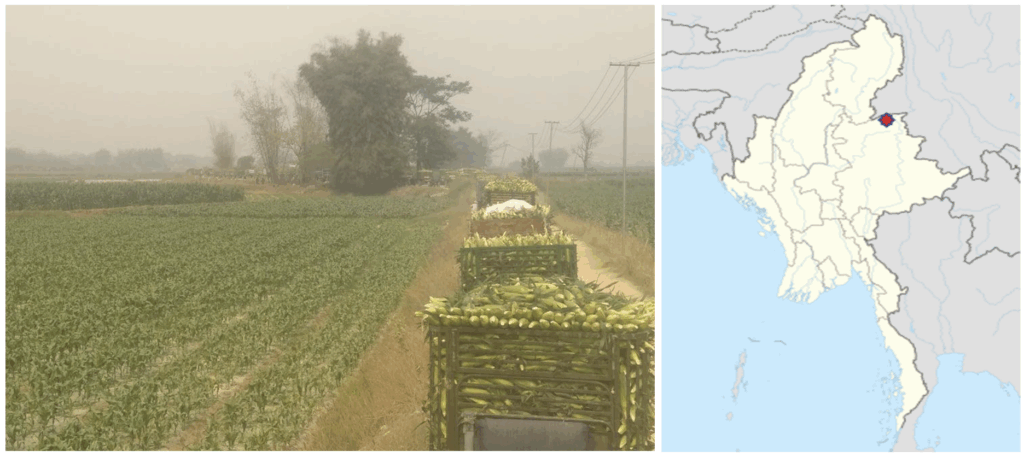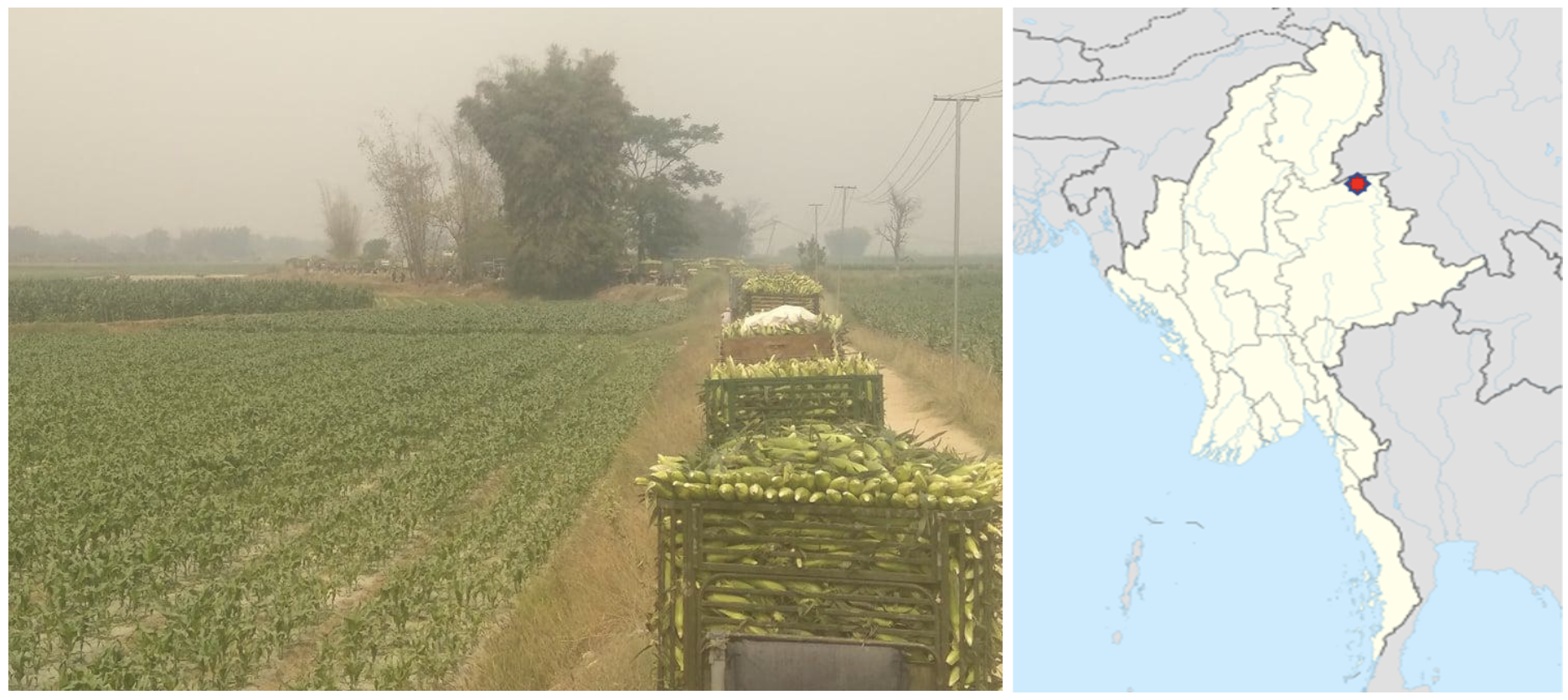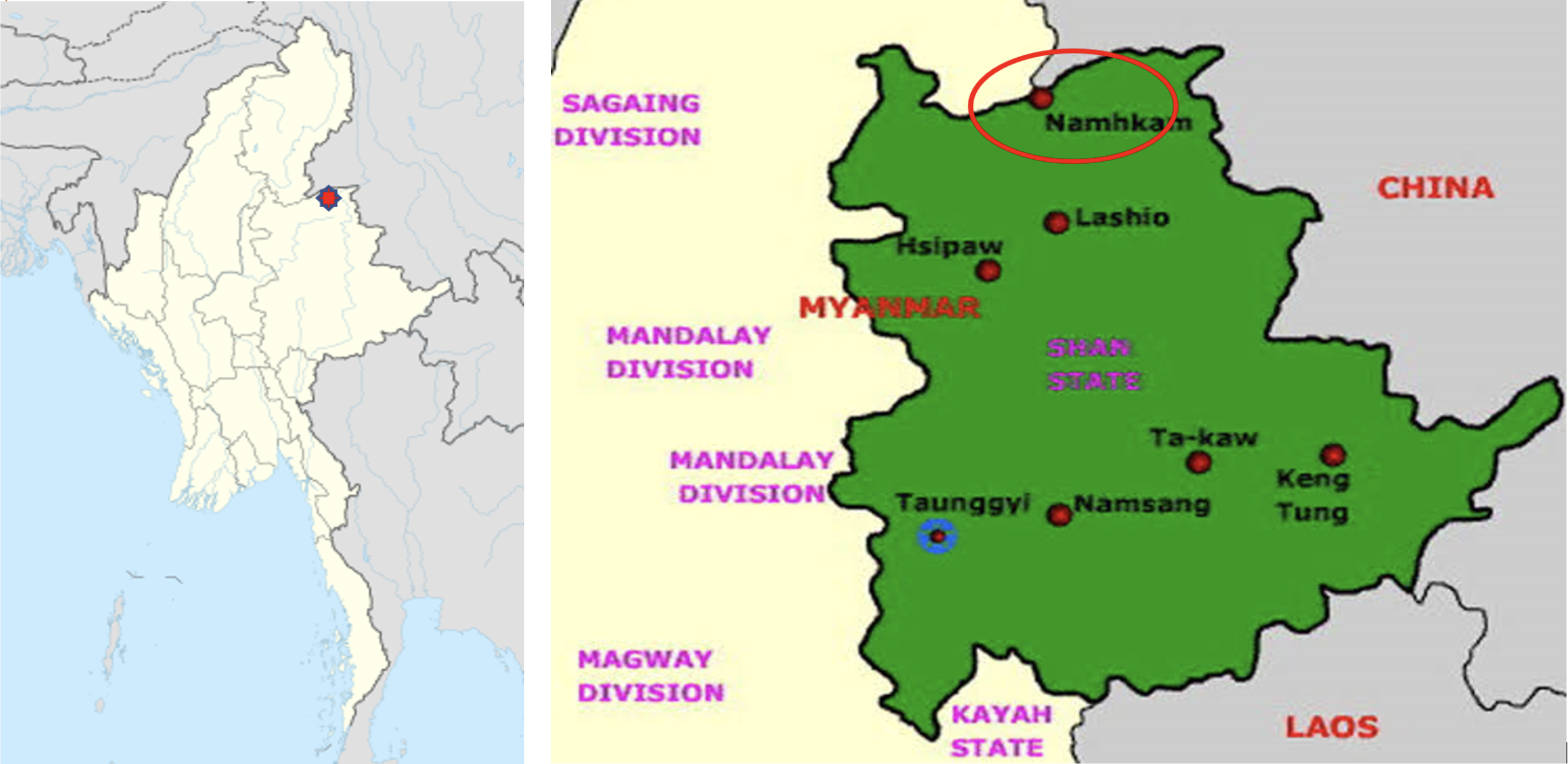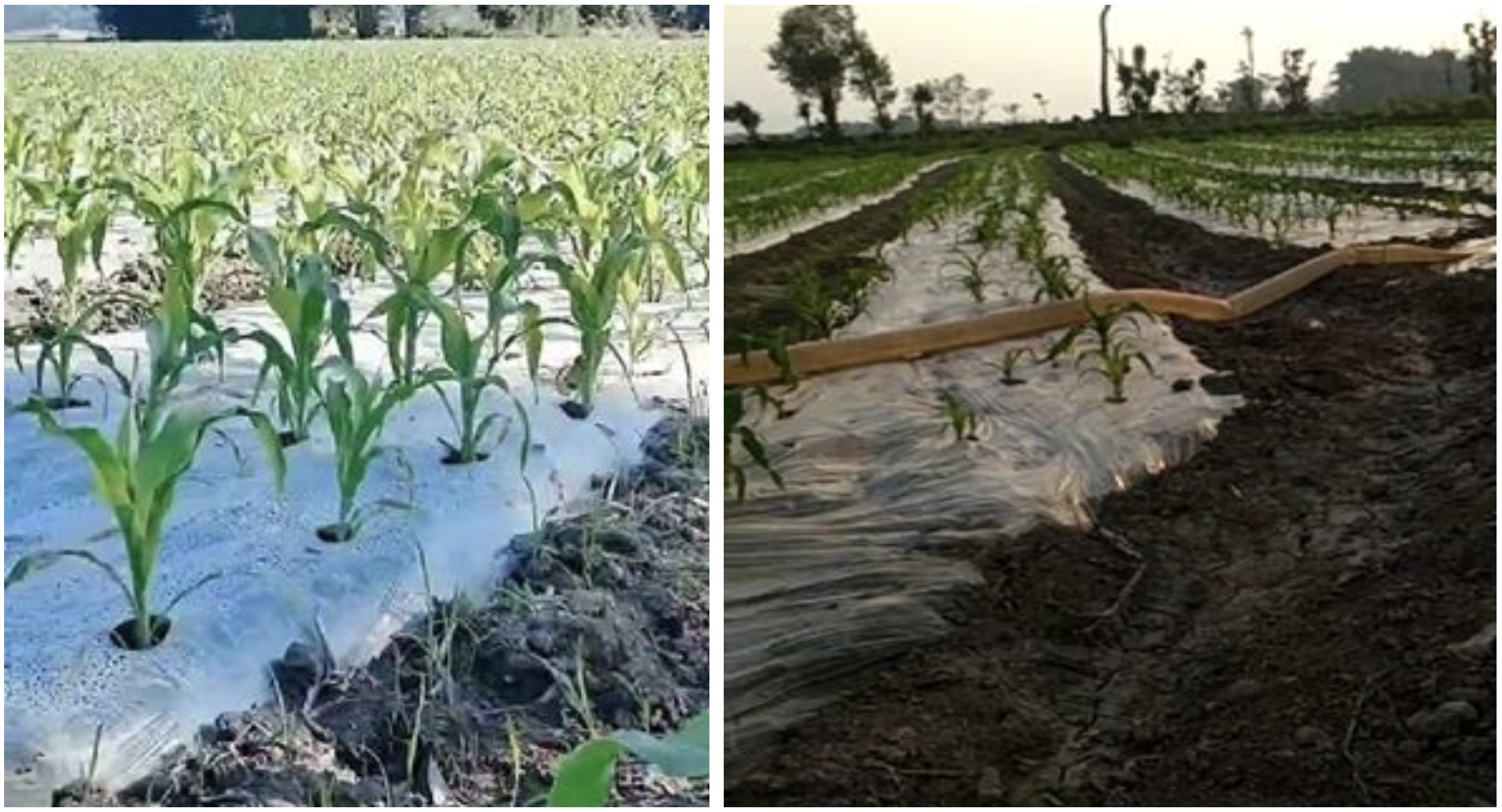Toward Inclusive border trade policy and a sustainable livelihood: Assessing Myanmar-China border trade impacts and corn farmers livelihood in Northern Shan State, Myanmar

Author: Nang Kham Hom Hleng
Advisor: Thida Chaiyapa
Introduction
It is a commonly accepted assumption that liberalization of trade in the cross-border front stimulates and accelerates economic growth. However, an effective foreign trade policy has to be accompanied by policy interventions, transformations on restrictions, changes in monetary policy and a series of structural reforms (BANERJEE et al., 2018). For economic growth, border trade has become a target for Myanmar, and it requests law and policy to comply with trade, contribution, and further investments. However, when there is an absence of certain trade policy, market volatility and lack of transparency, it could have several consequences and impacts on both countries and hit harder on vulnerable farmers. The Myanmar government amended trade policy and promoted the agriculture sector aiming to improve the economy, development of the country but rather introduced several challenges especially to farmers and no certain action has been taken. Since 2019, there are several significant trade policy changes and restrictions on cross-border activities after covid-19 and military coup which affects corn farmers’ livelihood, leading to economic instability, threatening social security. This brief explores how trade policy changes effect on local farmers and propose the implication of policy recommendations to sustainable livelihood and economic development.

Executive Summary
China and Myanmar have a long historical relationship thus, China’s economy has much influence on the Burma economy, trade, investment and Myanmar is also the energy source for China development in terms of natural resources, electricity. Among many investment sectors, agriculture is one of the projects in which Chinese investors are actively involved. Because of the population growth and increase in demand of consumption, it is a strategy to fulfil the need and food security purpose. Over the past two decades, increases in disposable income have resulted in increased domestic consumption. Therefore, growing demand for imports from Myanmar and other Southeast Asia countries for agriculture products and food due to increased consumption and aim to expand into global agriculture markets. Therefore, it creates a long-lasting relationship between Myanmar and China. Chinese company investment increases dramatically, and their main investment is on power, oil and gas, mining and agriculture (Lwin, 2019). More importantly, the Framework for Economic and Social Reforms (FESR) has been drafted to push ongoing reforms forward and to accelerate Myanmar’s greater integration into the international community. Policies emphasize agro-based industrial development, equitable resource-sharing among the regions and the country’s states, promoting local and foreign investments, effective implementation of people-centered development, and poverty reduction (Asian Development Bank (ADB). 2013). China-Myanmar border is a critical area for trade especially for agricultural products such as corn. However, due to the COVID-19 and political instability in Myanmar, China has enacted border control and import restriction which disrupted the corn market and severely impacted on corn farmers.
Methodology
This qualitative study examines the impact of Myanmar-China border trade policies on local corn farmers in Northern Shan State from 2019 to 2023. The research focuses on the China-Myanmar border, using secondary data analysis and online interviews with local farmers. The study reviewed articles, report, and case studies along with semi-structured interviews with farmers to gather insights. Such an analysis is necessary as there are various sources for secondary data analysis in response to the particularity of the research focus. (Dixon-Wooods, et al., 2004).
Objective
The research aims to assess how trade policy changes influence agricultural transformation and the livelihood of corn farmers. It explores the shift from traditional farming to commercial corn in response to Chinese demand and analyses the effects of political instability, border controls, and trade policy impacts on local farmers and to propose the implication of policy recommendations to sustainable livelihood and economic development.
1)What challenges impede economic development and border trade due to frequent changes of border trade policies, CEMC project and uncertain politics?
2) How has the livelihood of local farmers been transformed by corn commercialization, and what are the effects?
Case Study: Nam Kham Town, Northern Shan State
Nam Kham, a town in Northern Shan State, is a key location for corn forming due to its proximity to China. As Northern Shan State firstly experienced massive Chinese investment before expanding to other parts of the country because Northern Shan State is located at the border and there are long exit trade and relations between local and China traders. Chinese investment and agricultural demand has driven agrarian transformation in the region, leading to significant changes in farming practices and livelihoods.
There are different ethnicities in Nam Kham Town because Nam Kham is near the border of China and there are trade opportunities, and jobs availability and is more crowded than the other cities in the central of the Shan State. Shan People at Nam Kham Town rely on the rice and corn agriculture export to China. According to the latest census in 2014, there are 107,034 total population and 1209.1 km2. The majority of the people in the Township live in rural areas with only (28.3%) living in urban areas. In NamKham Township, 57.7 percent of the employed persons aged 15-64 are agricultural, forestry and fishery workers and is the highest proportion, followed by 10.8 per cent in services and sales workers and population 63.6 percent are self-employed in Agriculture, forestry and fishing which is the highest per cent (Department of Population Ministry of Labour, 2017).

Photo 1: Nam Kham Town Geography
Participant recruitment
Fifteen participants, including 10 farmers, 3 non-farmers, 1 local research, and 1 social activist, were interviewed. The interviews were conducted online, with assistance from local contact.
Table 1: Participants’ Demographic Profile
| Gender | Age | Occupation | Place |
| Male | 23 | College lecturer (researcher) | Online |
| Male | 30 | Non-Farmer: Construction worker | Online |
| Female | 35 | Farmer | Online |
| Female | 36 | Vendor (fruit seller) | Online |
| Male | 22 | Farmer | Online |
| Female | 23 | Farmer | Online |
| Male | 48 | Political Party representative and Farmer | Online |
| Male | 25 | Farmer | Online |
| Male | 38 | Farmer | Online |
| Female | 30 | Farmer | Online |
| Female | 56 | Non-Farmer: Fruit Seller | Online |
| Male | 44 | Farmer | Online |
| Female | 27 | Farmer | Online |
| Male | 26 | Farmer | Online |
| Male | 59 | Head village committee (Farmer) | Online |
Conceptual Framework
The framework is organized around three core components that focus on trade policies, corn farmers and the impacts. With these, the conceptual framework provides the structural views to understand the complex relation, policies, and the factors in this domain and to propose indication of policy recommendations to sustainable livelihood.

Figure 1: conceptual framework for this research
Source: Developed by researcher
Finding and Discussion
The findings of this research underscore the multifaceted challenges and impacts faced by corn farmers in Northern Shan State, Myanmar. The key issues explored in this discussion include the unstable border restricts, economic, social, and environmental impacts of evolving trading policies.
Border Trade Control and Import Restriction
Along with the disruption from the border closing from exporting to China in 2020, the Myanmar export rate has dropped and hindered the corn farmers as they cannot sell their crop. The February 2021 coup further worsened Myanmar trade in the economy already weakened by the COVID-19. Besides, the decline in exports was partly attributable to disruptions associated with the civil disobedience movement (CDM), resulting in a limited operational capacity for trade-related activities. China accounts for more than half of Myanmar’s land trade exports (World Bank Organization, 2021). Several factors have been affected on the corn farmers such as economic, social change and environmental impacts due to the border trade control and restriction.
Economic Impact
Farmers in Northern Shan State rely on agriculture mainly for their livelihood. Because it is geographically located on the border of China-Myanmar, the economic, trade were carried off well and all goods from the farm transported to sell in China before. In agriculture, in the past few years, people have changed to grow corn, and practices cash crop plantation according to the Chinese market demand. One of the largest investors in corn is Charoen Pokphand Group (CP group). Charoen Pokphand Group (CP) and their CP maize (or corn) contract farming scheme in upland rural Shan State, northern Myanmar started in the early 1990s in Shan State, northern Myanmar. CP Group’s vertically integrated maize production system predominately targeted supplying China’s domestic chicken-feed market (Woods, 2015). Corn is the significant driver of the agriculture transformation and livelihood change. However, although corn plantation is not very complicated, there is high investment such as fertilizers, pesticide, and other chemicals, tools to help it grow. Usually, corn can only grow once a year but if they want to grow every season, they need to have plastic wrap to cover the land, so it makes corn grow well, and faster, with an irrigation system. Therefore, there is a high cost of investment and there is also market risk because the price totally depends on the Chinese broker and relation between two borders.
Border control and market disruption has led to livelihood instability because farmers could not sell their corn, loss of income and increase poverty and debt trap. Farmers have no negotiation power and lack of information which make them become poorer or transform the local livelihood. Some villagers have to sell some of their land to pay the debt and put in the next investment. It is stated that contract farming arrangements occurring within a poorly governed agrarian context, which in Shan State is further marred by a litany of non-state armed groups, generally instead brings about more negative impacts, particularly where market concentration, unequal bargaining positions and lack of information allow powerful firms and middlemen to off-load risks to smallholders. This forces down farm gate prices and brings about negative impacts such as loss of access to village and household land, water, resources and other assets. Smallholders risk becoming locked into debt, which can lead to loss of productive assets including livestock and land (Woods, 2015). Farmers are facing increased challenges economically to their livelihoods and many are making less money or loss all invested as they didn’t sell any of their crops. And it is hard for them to invest in a new crop as they don’t have any savings, so they need to take out loans which drag them into the debt trap. Not only does it have an economic effect, but it also changes social culture, and the disappearance of indigenous knowledge.
Social Impact
Social capital, culture, and traditional knowledge is the bound for sustainable livelihood, thus culture, tradition value strengthen livelihood. It means that livelihood is also socially culturally constructed and traditional values can be critical in attaining social and livelihood security.
The farming practice has been changed after the expansion of the cash crop and modern technology, machine. Before, farmers use natural fertilizer and cow in their farm, and they grow different kind of crops. However, local farmers in Northern Shan State started to grow corn to earned extra income but it requires to use chemicals fertilizer, machine, and other irrigation tools.

(photos taken by the key informant)
Tools, seed companies draw local farmer interest to buy more products and most products come from China. And the technology keeps developing which makes the life of the poor harder to pursue. In addition, Local knowledge has been represented as something in opposition to modern knowledge and scientific knowledge. Because of the popularity of modern methods, agriculture practices, and fertilizer, people adapted to new ways of farming and turned back to local knowledge and farming practices. Thus, local knowledge has lost and failed to perceive it. Adapting new technologies is good, but local knowledge should be preserved and attained. When the farmers want to plant rice or other crop, they still need to use fertilizers and irrigation tools to help crop grow due to the soil quality is poor.
Environment and Climate Change impacts
The environment is the only resource nature gives to people and land, a suitable climate is needed for farmers and an important source for their living. However, because of the massive growth of corn, deforestation happened, and climate changes occur more often. Climate change is the result of the expansion of cash crops and threat to the security of livelihood. Because year by year, the villagers got lower output in the same field, and it required more fertilizer and more land to grow. And in some seasons, it is drought, so they have to use electricity and machine to generate irrigation systems. It costs more for villagers who don’t have machines, so they have to borrow from neighbours. Although climate change is caused, the expansion of farmland still continues because of family living and regular income. Climate change is a formidable threat to the local farmer’s living, so it pushes people to find it harder to live or search and mitigate the challenges. And after the lands were used a lot of fertilizer in growing corn, it makes the soil quality bad and takes time to make it fertilize naturally. So, if villagers want to plant other crops, they still need to use chemicals to help the plants grow because the soil is dry, and hard and the amount of chemical fertilizer increases every year. Rice plantation has been an alternative crop for farmers in Northern Shan State because rice can be stored for years, and it is their saving as well. However, paddy rice plantations take a longer time and are higher cost than corn. Thus, many farmers who did not have money for the next crop, decided to migrate to China to earn a living there.
Discussion
Agriculture is the backbone for Myanmar economic because Myanmar has advantage of vast land, water resource. Myanmar once used to be the largest rice exporter in Asia and well developing among Southeast Asia countries. However, because of the political instability, civil war and environment crisis, it turns Myanmar to be at the bottom in development and high human rights abuse. Myanmar economic strategy has been changed over time and later they focus on land border trade for economic development. The government tried to promote Agriculture sectors and develop new land tenure, grant for smallholders, and incentive policy for investment. Myanmar adopted a new development strategy and drafted with the aim to encourage investment. For many years, China is the long trader, largest investor in Myanmar.
The arrival of cash crop, corn plantation was expanded into Myanmar agriculture world. Before the widespread of corn production in the whole country, Northern Shan community first experienced agrarian transformation and commercial corn expansion. Nam Kham town, Northern Shan State geographically located at the border of China, thus there are exiting trade routes and local relationship since history. Through these facts, there are many impacts on local livelihood transformation by corn commercialization. Although there is a positive impact that people earn extra income, and there was market for corn before, the negative impacts are more. Nong Kong villagers live in uncertainty, insecurity, and mental aspects since they are living under the condition that they have no choice, no rights situation because they have to rely on farm products and Chinese market.
From findings, there are different causing the impacts on the livelihood of the villagers such as income instability, no current and future security, health effect and environment crisis threatening to living. The local farmers are encountered with the high risk of losing their livelihood, economic hardship and lost of indigenous knowledge which main drive to unsustainable livelihood. The local farmers face increased challenges to their livelihood and struggle with the new expensive cost effect crop. The only cash crop is serving rich people to be richer while poor farmers are starving for living. Most profits go to companies and local farmers become labour on their own land. Traditional knowledge is precious and significantly plays a role in people live. However, this indigenous knowledge disappears when the villagers adapt new way of farming which benefit to capitalist. One fact is that technology creates inequality in community and wealth as the villagers are not familiar with technologies and it is hard for them to adapt to new way of farming practices as most of them had no educational background. In addition, cash crops seem to make their lives harder when the crop price falls or no market for corn but still need to purchase expensive machine, fertilizers for next crop which lead them to debt trap or even to migrate to work. This is affecting basic human security because instability income makes villagers unable to access basic needs, child education and social well-being. Not only physical but also mental impacts because the villagers experienced depression and anxiety which lead to health effects. And there is not any government supports and initiation over the issue and impacts farmers experienced.
Economically, farmers face increasing financial instability due to the volatility of trade policies and the reliance on cash crops like corn. Socially, the shift towards commercial farming has led to the erosion of traditional farming practices and a weakening of community ties. Environmentally, the unsustainable agricultural practices associated with intensive corn farming, chemical used have resulted in degradation of local ecosystems and soil fertilized. Each of these issues is interconnected, contributing to the broader struggle for sustainable livelihoods in a region deeply affected by external political and economic forces.
Conclusion and Recommendations
Recommendations for inclusive border trade policy and toward a sustainable livelihood
- First, government initiation and participatory policy design is important. Because the previous trade policy and economic development plan, the local opinion, livelihood and situation has never been gauged and involved in any government initiation, policy formulation. For effective governance and border trade, the local voice, situation should be considered and engage for participatory approach in policy formulation, local trade policies. In addition, there should be capacity building or support programs for farmers education to ensure reach their full potential in plantation, participation in decision making, enhance in technology and in the market but still promote indigenous knowledge and culture. Importantly, trust building and transparent governance is required to address the challenges and encourage participation among stakeholders.
- Second, cross-border cooperation is important. Both countries, Myanmar and China should negotiate and enforce trade agreements that promote local products, facilitate the smooth flow of agriculture and market price insurance. Border trade has benefits to Myanmar and China and it is beyond national but transnational commercial, so it is important for two countries coordinated to address the border trade challenges, minimize the effects on farmers, reduce trade barriers, to stable border regulation and implementing inclusive local trade policy. To have effective policy implementation and fair trade, international organizations should be assisting in monitoring and evaluation of the improvement and impacts. In the agreement, it should include and adapt climate change matter and environmental sustainability practices.
- Finally, farmers play a crucial role in the process to policy formulating, community organization and agricultural development. Farmers has changed to plant rice which is a step to mitigate the effects but the farmers, villagers should form and strengthen the community organization, so they have power to bargain and protect market price volatility. Moreover, forming community organization, strengthen community ties can help, knowledge-sharing among farmer and participation in policy making, for development of community. Although forming community organization requires harmony, effort and time of the people, it can give a better results and benefits and become an example for other communities where experience the issues and come from local perspective and market protection with community-based solution.
In conclusion, further research on the issue is recommended and concerned institutions that more future research need to be conducted on the continue effects of commercial crop on local livelihood and how the situation has changed, role of stakeholders in order to know how the villagers and trader compromise and cope with the issue. It is recommended the state institution to conduct further investigation, local ground research and consultant project, campaign, training, promoting local knowledge. And it can also create more interaction and understanding of each other’s role. To respective government, the policy and rural economic development should be grounded from people, local need and effectively implement the law enforcement.
References
[1] BANERJEE, R., GAHAN, P., SATPATHY, S., & DASH, S. R. (2018). A study on cross border trade policies & developments with special reference to emerging economies. Revista Espacios | HOME. https://www.revistaespacios.com/
[2] Lwin, N. (2019, March 11). Infographic: 30 Years of Chinese Investment in Myanmar. Retrieved from https://www.irrawaddy.com/specials/infographic-30-years-chinese-investmentmyanmar.html .
[3] Asian Development Bank (ADB). (2013). Agriculture, Natural Resources, and Environment Initial Sector Assessment, Strategy, and Road Map. Asian Development Bank. doi: ISBN 978-92-9254-353-2
[4] World Bank Organization. (2021). Myanmar Trade & Investment Update. https://documents1.worldbank.org/curated/en/099135006272237487/pdf/P17700206f47fa0a10a5b20d1672ebf7760.pdf
[5] Woods, K. (2015). CP maize contract farming in Shan State, Myanmar: A regional case of a place-based corporate agro-feed system. In CP maize contract farming in Shan State, Myanmar: A regional case of a place-based corporate agro-feed system. Retrieved from https://www.iss.nl/sites/corporate/files/CMCP_35-_Woods.pdf
[6] Win, S. S. (2014a). Trade policy reforms in Myanmar (1988-2010). MERAL Yadanabon University. https://meral.edu.mm/record/448/files/Trade%20Policy%20Reforms.pdf
[7] The creative force in transnational commercial law. https://www.qmul.ac.uk/unidroit-itcl/media/ccls/docs/research/tclr-2-the-creative-force-in-transnational-commercial-law.pdf Goode, R. (2022).
[8] Kumar, R., Srinivas, K., Miah, M. A. M., & Qiu, H. (Eds) (2014). Assessment of the Maize Situation, Outlook and Opportunities in Asia. https://www.researchgate.net/publication/283795810_Assessment_of_the_Maize_Situation_Outlook_and_Opportunities_in_Asia
[9] World Bank Organization. (2020, April). Overview. Retrieved from https://www.worldbank.org/en/country/myanmar/overview#3
[10] Shee, P. K. (2002). The Political Economy of China-Myanmar Relations: Strategic and Economic
[11] Myanmar Digital News. (2022, January 24). Strive for enhancing the Border Trade Process. Retrieved December 9, 2022, from https://www.mdn.gov.mm/en/strive-enhancing-bordertrade-process
Download full paper: Click
